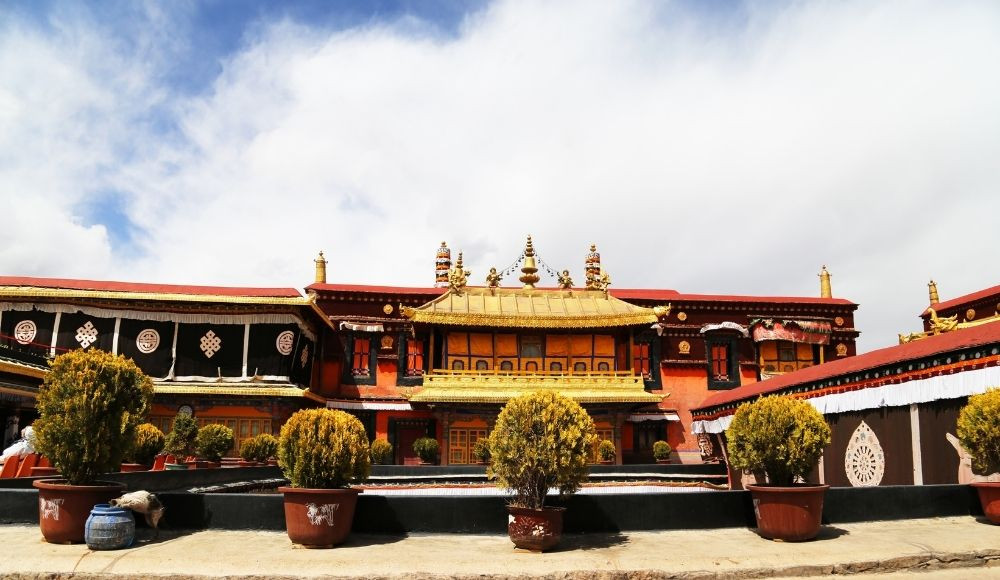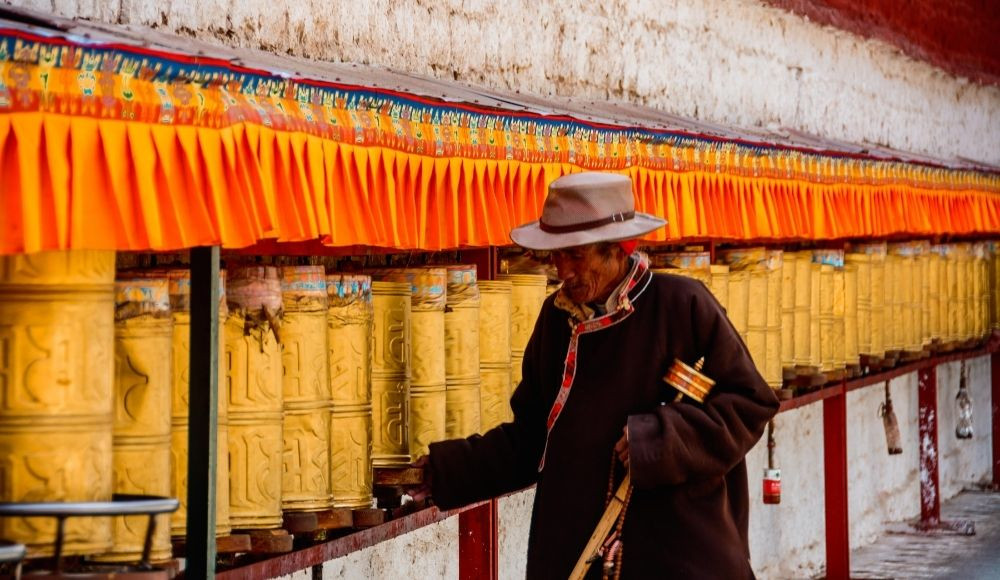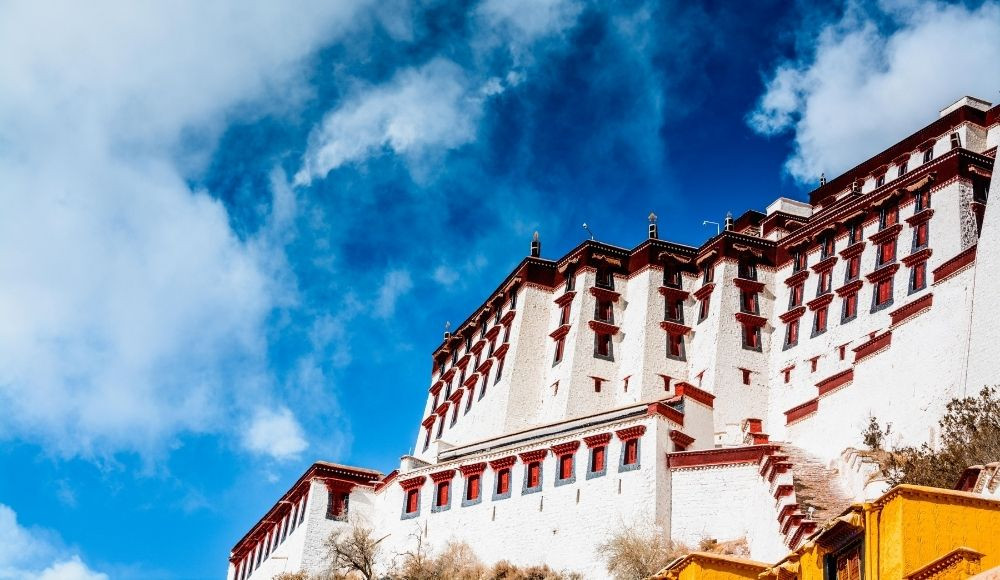Explore Tibet Tour
Trip Facts
Highlights of Explore Tibet Tour
- A breathtaking tour to ‘’the roof of the world - Tibet.
- Iconic religious landmarks exploration in Lhasa, Tibet.
- One of the highest regions on earth with captivating landscapes.
- Remarkable geography and endless mountain chain views throughout the trip.
- An amazing journey to spectacular religious sites and majestic lakes and high passes.
Trip Overview
Yet another amazing tour to one of the most beautiful and peaceful places in the world - Tibet otherwise known as the ‘’forbidden land’’. This trip takes you on a one-of-a-kind journey that will leave a deep impression on you. This trip is an absolute opportunity to explore the unique culture and simply soak in the beauty. You will witness the untamed beauty and pure spirituality while you walk on the streets of Lhasa and visit the iconic monasteries. The beautiful place is bounded by the Himalayas with unique geography that will surprise you for sure. This tour allows you to explore its untouched and isolated beauty and culture. Tibet, Lhasa is known as the spiritual hub for Tibetan Buddhism and here you can learn and experience things in depth.
Tibet welcomes everyone from around the world with warm hospitality and never-ending peace. People visit Tibet for various reasons some visit for tranquility and spiritual awakening and others to explore the breathtaking beauty that this place holds. Most people visit Tibet for spiritual and religious purposes as it is known as the holy land. From the highest palace to the holiest mountain Tibet has it all. Trips like Kailash Mansarovar and Everest (north) base camp are quite popular in Tibet. Tibet is an isolated place with little exposure to the world meaning you will get to see the authentic and ancient beauties till this date. Most of the religious sites are decorated with vibrant prayer flags and a strong smell of divine traditional incense that marks its territory perfectly. The massive structures might intimate one while claiming the other with their charm. People doing their rituals (Kora) and other traditional rituals are parts of Tibet that reflect its dominant religion and local belief system.
Lhasa which is anciently known as the city of golden roofs boasts shiny pinnacles over their holy monasteries and temples that sparkle in the daylight. You will explore some of the wonderful attractions that include iconic monasteries, temples, and landscapes. Visiting the sites and seeing the place will make you understand and notice the ancient beauty engraved within the monuments. Besides the artificial monuments, you will also visit the gorgeous lakes and high passes to get a panoramic view of the place. The view will leave you speechless, the picturesque place looks like it's out of this world. Explore Tibet for lifetime memories and a unique travel experience.
Attractions of the tour:
Tibet, Lhasa is one of the most iconic cities in the world with extraordinary landmarks and dominant Tibetan Buddhism roots. Tibet is known as the hidden kingdom as it is behind the majestic Mount Everest - The highest mountain on Earth. Tibet is rich in cultural and natural resources from breathtaking landmarks to jaw-dropping landscapes, you will witness the beauty of Tibet. Besides the architectural beauty, you will also witness the daily lifestyle of the natives while your visit to Tibet, Lhasa. Roaming around streets witnessing the peace and experiencing ancient beauty up close creates amazing memories and a lifetime travel experience.
Potala Palace - Iconic Winter Palace of Dalai Lama.
Potala Palace locally known as the winter palace as it is the residence of his holiness Dalai Lama. Potala Palace is the highest elevated palace in the world with majestic architecture. Potala Palace stands strong at and elevation of 3,700m with the dominant religious beacon. The structure is one of the sacred places in Tibet for Tibetan Buddhists all over the world. The portal palace resembles a large walled fortress with its dominant structure that outshines everything around it. The base of the palace is filled with tranquility and the strong smell of incense offered by its devotees. The palace is divided into two parts which are divided into two part red and white. The white part of the palace is used as Dalai Lama’s residence and the red part is used as the Buddhist administrative part where monks learn the Tibetan Buddhist doctrines and practice teachings. The entire architecture combines around 1000 rooms where there are tombs of all 8 Dalai Lamas, numerous shrines, thousands of hand-painted sacred scrolls, murals, and sculptures covered in precious jewels.
Jokhang Temple - The House of Buddha.
Jokhang, which simply translates to the house of Budhha in Tibetan language is one of the most sacred Buddhist temples in Tibetan Buddhism. It is considered the spiritual heart of Tibet as it houses the precious statue of Buddha from Sakyamuni Buddha. The Jokhang temple was built by Tubo King Srongtsen Gampo in 652 to marry the Nepali princess. He married Princess Bhirkuti now also known as the green Tara in Tibetan iconography. The princess brought several statues of Buddha from the time when as dowry which today sit inside the temple. The architecture of this temple is a bit more unique than other monuments which are inspired by Nepal and Indian architecture. Inside the temple is the precious statue brought by the hr princess covered in a traditional robe and priceless antique jewelry. Outside the temple, you will see devotees doing rituals and Kora which represents the strong belief system of the Tibetan Buddhists.
Barkhor Street - The Holy Path.
Barkhor Street or ‘’Barkhor pathway’’ Khor - meaning related to circumambulation in the Tibetan language. The divine road is located around the Jokhang temple. Barkhor Street is the path surrounding the sacred Jokhang temple. The street is one of the most popular attractions in Lhasa as it is surrounded by local restaurants, cafes, exotic handmade items shops, and street vendors. The road is packed with tourists and locals making it lively and exciting. The street is filled with divine incense smell and hardcore devotees doing their Kora. Tibetan Buddhists are very serious regarding their fate and religion and you can see by the way they commit to it. They lay on the grond on their stomach and get up chanting mantras while repeating the whole process until the circumambulation is completed. This sight is common and you will get to see it almost in every temple and monastery. People walk in a clockwise direction as it is a ritual and do not overtake people as it is considered disrespectful.
Drepung Monastery - The Great Three ‘’Gelug Gompas’’.
Drepung translates to ‘’rice heap’’ in the Tibetan language and is one of the great three Gelug monasteries (Tibetan Buddhist University). It is called the rice heap as people believe it looks like a heap of rice on the hill from a distance. This monastery has a name and another one is Nalanda of Tibet and which means giver of knowledge. It is the biggest monastery in Tibet and the massive monasteries compose of unique architecture and spectacular parts. It is also the formal palace of the Dalai Lama before the construction of the Potala Palace was completed. Drepung is one of the biggest Buddhist monasteries and inside the monastery, there are four largest Drepung colleges. The great colleges are Dratsang, the largest of Drepung’s colleges, Drepung Gomang Dratsang, the second to Loseling College, and Drepung Deyang Dratsang, the smallest college. Drepung monastery also hosts one of the most prominent festivals - the Shoton festival also known as the grandest Buddha unfolding in Lhasa.
Sera Monastery - The Hail Monastery.
Sera Monastery is one of the most beloved monasteries by both tourists and locals. The word ‘’Sera’’ translates to wild roses and it is believed that the hill behind the monastery was covered in multicolor wild roses during the construction of the monastery. The Sera monastery is primarily known for its monk's debate as it is interesting and a unique thing to experience. You can see beautiful architecture and intricate Tibetan art style up close inside the temple. Sera Monastery captures your attention with its tranquil chanting and peaceful environment. Sera monastery is known for its fascinating debate among the monks.in the courtyard of the monastery you will see monks impairs one sitting and another standing one sitting answers the questions asked by the monk standing. They speak in their native language, about the Tibetan Buddhist doctrines. You might not understand what exactly they are saying but you can know who is losing the debate and here's how: if the standing monk claps the hand then you know it’s a crack/wrong answer. They repeat until the evening and call it a day the debate time is 3 PM-4 PM every day except for Sundays.
Yamdrok Tso - The Jade Lake of Tibet.
Yamdrok Tso (Lake) is one of the holy lakes in Tibet which is one of the most beautiful landscapes. The lake is located on the south bank of the Yarlung Zangbo River on the way to Shigatse. The Yamdrok is known as the Jade Lake for its enchanting turquoise color. It is the sacred lake also being the most beautiful one. This wonderful lake is a perfect place to visit for those that admire the breathtaking beauty of Tibet’s natural landscape away from the hustling and bustling city area. The lake is surrounded by a landscape of mountains and plains that perfectly frames the lake for gorgeous photos, including snow-capped mountains, Himalaya glaciers, and numerous small islands around the lake. You will drive through a high pass called Gampala Pass at an altitude of 4,790m above sea level. You will get a stunning view of the entire lake along with the surrounding landscapes from the Pass. you can get close to the lake and take pictures with animals such as yaks and Tibetan massifs beautifully decorated by the locals for pictures however, keep in mind that taking pictures with these animals will charge you some money.
Palcho Monastery - Lucky and Happy Monastery.
Palcho Monastery is located in Gyantse town of Shigatse in west Tibet and is also known as Palcho Monastery or the Shekar Gyantse, which is the main monastery in the village of Nyangchu River in Gyantse county. It is a large and complex structure of monastic structures composed of monasteries, fortresses, and temples. Palcho means lucky and happy in the Tibetan language. The Palcho monastery gains its popularity from its unique structure which is a combination of Han, Tibetan, and Nepali Buddhists. The significant reason for its high status in Tibetan Buddhism is that it houses three prominent sects of Tibetan Buddhism which are Gelug, Sakyapa, and Kadampa together. The Palcho monastery composes of a temple, monastery, and fortress. The most astounding monastery is a symbol of Gyantse i.e. the Bodui Dagoba (Tibetan name Pelkhor Choede) popularly known as ‘’Kumbum’’. Kumbum is the 3-D representation of Mandala which is very different than any religious structure you will find in Tibet. Inside the monastery, there are ancient statues, murals, and carvings that represent the high-standard art and teachings and doctrines in the form of art. Besides the architectural and religious beauty, you will get to see the semi-arid landscape with snow-capped mountains from the location.
Tashilhunpo Monastery - The Heap of Glory.
Tashilihunpo monastery which is locally known as the Heap of Glory is situated in Nyiseri mountain in the west of Shigatse city built in 1447 by Gedun Drupa, the first Dalai Lama. Tashilihunpo monastery largest monastery in the Tsang area which is also the traditional seat of successive Panchen Lama, Tibet’s second-highest incarnation. It is also one of the great six Gelugpa monasteries in Tibetan Buddhism. Another five are Derpung, Sera, Ganden, Kumbum, and Labrang monasteries. The monastery attracts lots of tourists as it has a very unique architectural structure that includes Caqen Hall, Chapel of Jampa, four great Dratsangs, 56 sutra halls, and 64 Kamcuns with a spectacular view of the landscape. Pilgrims pay homage by going around the site in a clockwise direction which is called Kora, you can participate in it as well.
Detailed Itinerary
Arrival in Lhasa, Welcome!!
Lhasa Sightseeing
Lhasa Monastery Sightseeing
Lhasa - Gyantse - Shigatse
Visit Tashilhunpo Monastery, Drive Back to Lhasa
Departure
Trip Guide
The information given about the Explore Tibet Tour is in-depth, feel free to contact us 24/7 for any kind of assistance through Email or WhatsApp. You can write an email if this trip doesn't fit your vacation schedule and requirements. We aim to offer the best possible travel experience to the customers. Depending on the needs of the visitors and the group size, we customize each vacation package. We will put together a bespoke itinerary just for your private group.
Travel insurance: Travel insurance is essential before traveling to a new place especially when you are traveling for adventure. Travel insurance covers risks such as loss of personal belongings and unexpected expenses. Travel insurance also covers sudden medical emergencies such as accidents. It also covers high-altitude emergencies. Travel insurance is not compulsory but highly recommended.
Medical emergency: If you face any medical emergency such as high altitude sickness your professional guide will help you and transfer you for medical attention. Tibet lies at an elevation above 3000 and high altitude sickness is a possible medical condition. For such a situation, your guide carries a well-equipped first aid kit along with portable oxygen, ensuring nothing happens to you.
High-altitude sickness: During the Tibet tour you will stay above 3,000m. Tibet is the only city located at this altitude, increasing the chances of getting altitude sickness. Noticing a lower oxygen level is normal and you will acclimatize on the first day before you start your tour. Altitude sickness is unpredictable; it can happen to anyone despite being physically and mentally fit. As you gain altitude, the chances of altitude sickness increase slightly. To avoid getting altitude sickness you should drink 5-6 lt water per/day and food with high carbohydrates. Sauntering and acclimatizing decrease the chances of getting altitude sickness. Focus on your breathing and maintain your walking pace.
Do’s and Don’t:
-
Select the ideal time to travel.
-
Select a reputed trekking/ travel organization.
-
Training and getting ready for any kind of situation are necessary.
-
Carry all the essential paperwork (Tibet entry permit).
-
Maintaining body hydration is important while traveling to high elevations.
-
Don’t take pictures and videos inside the monasteries, temples, or any religious sites.
-
Hire a licensed tour guide to get information about the place such as its history, and importance.
-
Wear appropriate clothing during the monastery visit.
-
Respect the culture and people of the area.
-
Travel for experience and not for the sake of traveling.
-
Don’t litter, put trash in its place.
Why with Altitude Himalaya: Altitude Himalaya is one of Nepal’s growing travel companies providing excellent service to its clients. We believe in providing quality experiences and memories. We are concerned about maintaining and following our standard service, including a private transfer, at least a 3-star hotel accommodation in urban areas, the best available lodges/tea houses at the trekking trails, and dedicated personalized assistance. Additionally, we also operate our trips in Bhutan and Nepal.
Frequently Asked Questions
-
Where is Tibet located?
Tibet is located on the northern side of the Himalayas north of Nepal, India, Bhutan, and Myanmar on the highest region of the Tibetan plateau. It lies on the border of Nepal and China and you can access Tibet directly from Nepal either by flight or drive.
-
How can I visit Tibet and which is the easiest way?
You can access Tibet in two ways one is directly from China and another is from Nepal which is comparatively the easiest way. One is from China, Mainland, you can either take a flight from Beijing to Lhasa with a stopover in Xining or a direct flight. You can also take the train on the Qinghai Tibet railway which will take around 40 hours to complete the journey. Another way to visit Tibet is from Nepal which is competitively easier than from China. You can take a flight from Nepal to Tibet which is the fastest route. (Flight time 1 hour 45 minutes) The direct flight operates from Kathmandu, Nepal to Tibet, Lhasa which is the best way for those who are short on time.
-
When is the best time to visit Tibet and why?
The best time to visit Tibet is between May to October when the skies are clear and decent temperature is decent. July to August is the summer season when the temperature is warmer and also in August one of the most important festivals is called Shoton (Yogurt festival). During the winter season, the weather is crystal clear giving you an amazing view of the surrounding landscapes and endless mountain chains.
-
Do I need to visit China to visit Tibet or is there another route?
Tibet is the autonomous region of China however you don't have to visit China directly to travel to Tibet as you can access Tibet through Nepal with a special permit. You can travel to Tibet either by land or air both from Nepal without having to visit China directly.
-
Can I travel to Tibet alone?
Unfortunately No, you cannot travel alone in Tibet as it is prohibited by the government. You must hire a government-licensed tour guide throughout the tour. Travelers are only allowed to visit Tibet through a travel agency that will take care of your accommodation, transportation, and permits.
-
What kind of accommodations can I get during the trip to Tibet?
Tibet has options regarding accommodation from 3-star hotels to luxurious 5-star hotels in the major city area however, there are limited choices in the remote areas. In remote areas, there are tented accommodations with comfortable bedding and basic amenities run by the locals.
-
What kind of food will I get can I get international cuisines too?
You can get varieties of food during your trip to Tibet from authentic Tibetan cuisine to other delicious international food such as Indian and Nepali food along with your comfort fast food as numerous fast food restaurants serve comfort food in Tibet.
-
What are the chances of getting altitude sickness and how to prevent it?
Tibet’s average altitude is 3,500 m to 4,000m and the chances of getting high altitude sickness get higher. To reduce the chances of getting high altitude sickness you must acclimatize and adapt to the surrounding environment. Having high carbohydrate food, and plenty of water (4-5 lt) per day helps you prevent any possible chances of getting high altitude sickness.
-
Do I need to bring oxygen cans for the trip?
It is not necessary to bring oxygen with you during the trip as you can get it in hotels, clinics, and hospitals easily. If you need the oxygen you can purchase it in the hotels directly but we suggest you not to use the oxygen supply and adapt to the altitude by naturally yourself.
-
What kind of documents do I need to bring to apply for a permit?
You will need a special permit to visit Tibet. Without the Tibet entry permit, you are not allowed to travel to Tibet as per government law. It takes around 8 to 10 days to get the Tibet permit after applying for it. Typically the permit is valid for a maximum of three months. You can get the permits through a travel agency either directly from China or Nepal.
Services Includes
-
Airport pick up and drop off on a private basis.
-
A private A/C vehicle for all the mentioned transportation and sightseeing.
-
All (05 Nights) hotel accommodations are based on double-sharing deluxe rooms.
-
All mentioned sightseeing entrance fees.
-
Daily breakfast and dinner at the hotel.
-
All government and local tourism taxes.
-
Professional experienced licensed tour guide throughout the tour.
-
Well-equipped medical kit along with portable oxygen.
-
Driver and guide’s allowance, salary, fuel cost, and toll/taxes.
-
Tibet group visa fee
Services Excludes
-
Personal expenses
-
International flight to reach Tibet.
-
Tips to driver and tour guide. (Not required but recommended)
-
Services that aren’t mentioned above.
Why Travel With Altitude Himalaya?
We believe in the quality services to accommodate our guests 360 degrees need with tour personalization and customization. Our dedicated and experienced team believes not only in arranging trips, but making creating life long memories. Our travel experience within the region of Nepal, Bhutan and Tibet could make a memorable trip of yours.
Confirm Your reservation Now


TALK TO AN EXPERT
we can help you find your perfect holiday
Mr. Kiran has experience of 10+ years in tourism across Nepal, Bhutan and Tibet holiday arrangements to thousands of travellers from around the world. He will help you to figure out the best possible vacation plan according to your choice and preference.







 Duration
6 days
Duration
6 days
 Trip Difficulty
Easy
Trip Difficulty
Easy
 Highest Point
4300 m.
Highest Point
4300 m.
 Average Group Size
2-10
Average Group Size
2-10
 Trip Code
ETT
Trip Code
ETT
 Start Point
Lhasa
Start Point
Lhasa
 Trip End Point
Lhasa
Trip End Point
Lhasa
 Accomodation
3 Star Hotels
Accomodation
3 Star Hotels
 Meals
As Mentioned
Meals
As Mentioned
 Transportation
On Private Basis
Transportation
On Private Basis
 Send an email
Send an email +9779823000055
+9779823000055 +9779823000055
+9779823000055